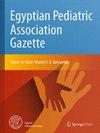足月新生儿自发性乒乓球骨折--病例报告
IF 0.5
Q4 PEDIATRICS
引用次数: 0
摘要
剖宫产新生儿非外伤性凹陷性颅骨骨折是一种罕见现象。文献报道的发病率为每 10,000 名活产婴儿中有 1 至 2.5 例。由于易延展性,颅骨从正常的凸形转变为凹形。这是由于新生儿期骨化不完全造成的。因此,它通常被称为乒乓球骨折。临床表现可能因骨折的严重程度和潜在的实质损伤而异。文献中报道的大多数病例均采用保守治疗。但在严重病例中,可能会建议进行手术抬高并使用医疗器械。我们报告了一名患有自发性乒乓球骨折的足月女新生儿的表现、病程和处理方法。该新生儿没有产前感染、难产或分娩过程中器械损伤的病史。对该婴儿进行了彻底检查,以确定是否存在潜在的实质损伤,观察是否存在神经系统异常,并对其进行了保守治疗。因此,乒乓球骨折或自发性新生儿颅骨骨折虽然罕见,但在临床实践中也会遇到。全面的临床检查和神经系统评估有助于做出处理决定。本文章由计算机程序翻译,如有差异,请以英文原文为准。
Spontaneous ping-pong fracture in a full-term neonate—a case report
Non-traumatic depressed skull fracture in a neonate delivered by cesarean section is a rare phenomenon. The incidence reported in literature varies between 1 and 2.5 in every 10,000 live births. The skull is transformed from its normal convex shape to a more concave form due to easy malleability. This is secondary to the lack of complete ossification in the neonatal period. Hence, it is commonly known as ping-pong fracture. The clinical presentation may vary depending on the severity of the fracture and underlying parenchymal injury. Most cases reported in literature have been managed conservatively. However, surgical elevation and the use of medical devices may be advised in severe cases. We report the presentation, course, and management of a term female neonate with a spontaneous ping-pong fracture. The neonate had no history suggestive of antenatal insult, difficult labor, or trauma due to instrumentation during delivery. The infant was thoroughly investigated for underlying parenchymal injury, observed for neurological abnormality, and managed conservatively. Thus, ping-pong fractures or spontaneous neonatal skull fractures are rare but can be encountered in clinical practice. A thorough clinical examination and neurological assessment can aid management decisions.
求助全文
通过发布文献求助,成功后即可免费获取论文全文。
去求助
来源期刊

Egyptian Pediatric Association Gazette
PEDIATRICS-
自引率
0.00%
发文量
32
审稿时长
9 weeks
期刊介绍:
The Gazette is the official journal of the Egyptian Pediatric Association. The main purpose of the Gazette is to provide a place for the publication of high-quality papers documenting recent advances and new developments in both pediatrics and pediatric surgery in clinical and experimental settings. An equally important purpose of the Gazette is to publish local and regional issues related to children and child care. The Gazette welcomes original papers, review articles, case reports and short communications as well as short technical reports. Papers submitted to the Gazette are peer-reviewed by a large review board. The Gazette also offers CME quizzes, credits for which can be claimed from either the EPA website or the EPA headquarters. Fields of interest: all aspects of pediatrics, pediatric surgery, child health and child care. The Gazette complies with the Uniform Requirements for Manuscripts submitted to biomedical journals as recommended by the International Committee of Medical Journal Editors (ICMJE).
 求助内容:
求助内容: 应助结果提醒方式:
应助结果提醒方式:


